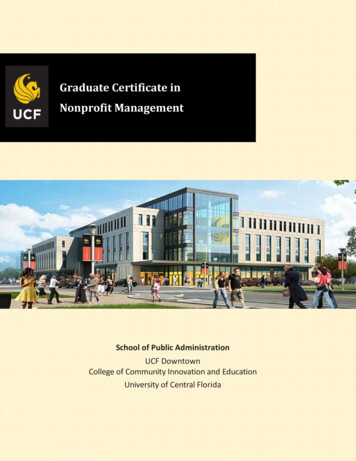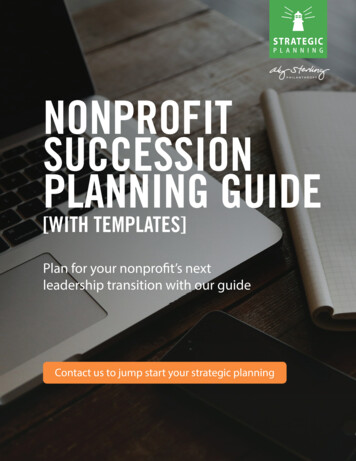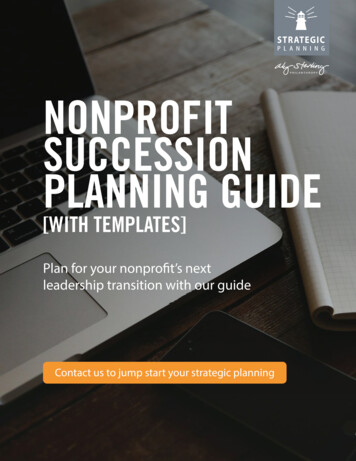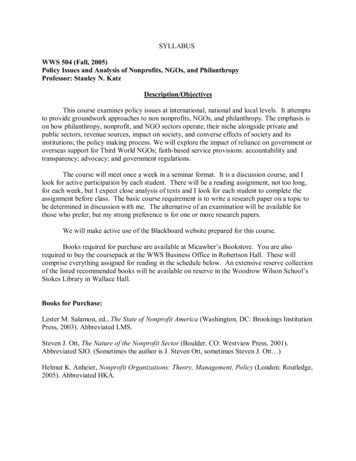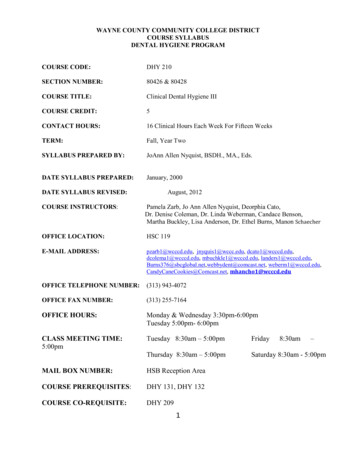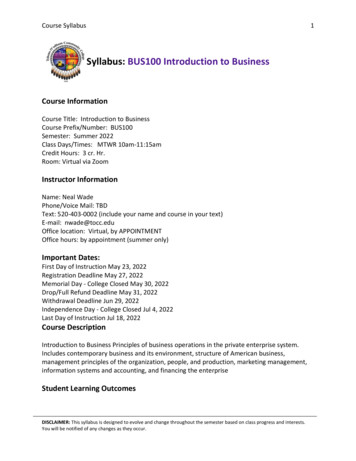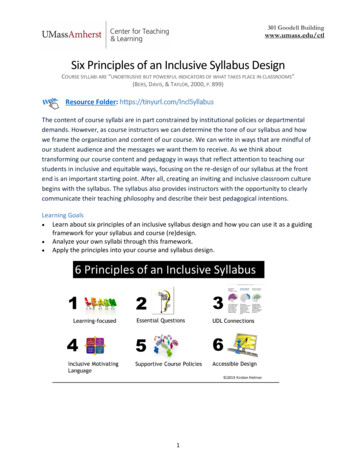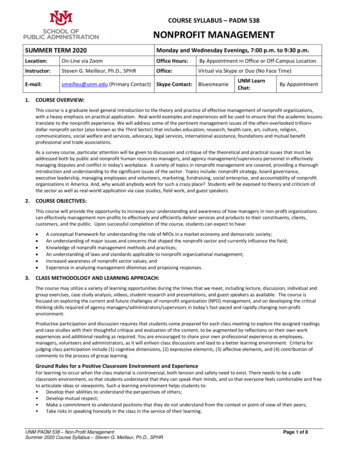
Transcription
COURSE SYLLABUS – PADM 538NONPROFIT MANAGEMENTSUMMER TERM 2020Monday and Wednesday Evenings, 7:00 p.m. to 9:30 p.m.Location:On-Line via ZoomOffice Hours:By Appointment in Office or Off-Campus LocationInstructor:Steven G. Meilleur, Ph.D., SPHROffice:Virtual via Skype or Duo (No Face Time)E-mail:smeilleu@unm.edu (Primary Contact) Skype Contact:1.BluesmeanieUNM LearnChat:By AppointmentCOURSE OVERVIEW:This course is a graduate level general introduction to the theory and practice of effective management of nonprofit organizations,with a heavy emphasis on practical application. Real world examples and experiences will be used to ensure that the academic lessonstranslate to the nonprofit experience. We will address some of the pertinent management issues of the often-overlooked trillion dollar nonprofit sector (also known as the Third Sector) that includes education, research, health care, art, culture, religion,communications, social welfare and services, advocacy, legal services, international assistance, foundations and mutual benefitprofessional and trade associations.As a survey course, particular attention will be given to discussion and critique of the theoretical and practical issues that must beaddressed both by public and nonprofit human resources managers, and agency management/supervisory personnel in effectivelymanaging disputes and conflict in today’s workplace. A variety of topics in nonprofit management are covered, providing a thoroughintroduction and understanding to the significant issues of the sector. Topics include: nonprofit strategy, board governance,executive leadership, managing employees and volunteers, marketing, fundraising, social enterprise, and accountability of nonprofitorganizations in America. And, why would anybody work for such a crazy place? Students will be exposed to theory and criticism ofthe sector as well as real-world application via case studies, field work, and guest speakers.2.COURSE OBJECTIVES:This course will provide the opportunity to increase your understanding and awareness of how managers in non-profit organizationscan effectively management non-profits to effectively and efficiently deliver services and products to their constituents, clients,customers, and the public. Upon successful completion of the course, students can expect to have: 3.A conceptual framework for understanding the role of NPOs in a market economy and democratic society;An understanding of major issues and concerns that shaped the nonprofit sector and currently influence the field;Knowledge of nonprofit management methods and practices;An understanding of laws and standards applicable to nonprofit organizational management;Increased awareness of nonprofit sector values; andExperience in analyzing management dilemmas and proposing responses.CLASS METHODOLOGY AND LEARNING APPROACH:The course may utilize a variety of learning opportunities during the times that we meet, including lecture, discussion, individual andgroup exercises, case study analysis, videos, student research and presentations, and guest speakers as available. The course isfocused on exploring the current and future challenges of nonprofit organization (NPO) management, and on developing the criticalthinking skills required of agency managers/administrators/supervisors in today’s fast-paced and rapidly changing non-profitenvironment.Productive participation and discussion requires that students come prepared for each class meeting to explore the assigned readingsand case studies with their thoughtful critique and evaluation of the content, to be augmented by reflections on their own workexperiences and additional reading as required. You are encouraged to share your own professional experience as employees,managers, volunteers and administrators, as it will enliven class discussions and lead to a better learning environment. Criteria forjudging class participation include (1) cognitive dimensions, (2) expressive elements, (3) affective elements, and (4) contribution ofcomments to the process of group learning.Ground Rules for a Positive Classroom Environment and ExperienceFor learning to occur when the class material is controversial, both tension and safety need to exist. There needs to be a safeclassroom environment, so that students understand that they can speak their minds, and so that everyone feels comfortable and freeto articulate ideas or viewpoints. Such a learning environment helps students to: Develop their abilities to understand the perspectives of others; Develop mutual respect; Make a commitment to understand positions that they do not understand from the context or point of view of their peers; Take risks in speaking honestly in the class in the service of their learning.UNM PADM 538 – Non-Profit ManagementSummer 2020 Course Syllabus – Steven G. Meilleur, Ph.D., SPHRPage 1 of 8
Expected class norms to enhance a safe learning environment include: Students should respect confidentiality-personal information or student comments should not get shared outside the classroom; Students should listen respectfully to different perspectives-let people finish sentences before responding; Students should respond to what has been said, not the person saying it-responses should not be personalized; Students should speak for themselves and not for others (including groups to which they belong); Students have the right to be silent in large group discussions.Class discussion allows for disagreement; however, comments must be sustained by evidence, in particular evidence from classmaterials and readings. Class comments are not to be unsupported assertions of opinion, and never ad hominem (personal) attacks.Incivility or rudeness of any kind is unacceptable. This includes carrying on conversations during class, checking cell phones or otherelectronic devices for messages, texting, and other distractions. The bottom line is this – my expectation is that you behaveprofessionally at all times in class.4.COURSE MANAGEMENT:As a survey course, we will address new topics each session, endeavoring to understand their relationships as we discuss, analyze, andcritique leadership theory and practice. I will utilize UNM Learn to post the course syllabus, course assignments, lecture notes, anddiscussions, as well as some email messaging. Primarily, students should use my regular UNM e-mail account to communicate andsend assignments electronically. DO NOT submit your papers to me via UNM Learn Mail. Finally, students will be able to accessSupplemental Readings online at the class UNM Learn site. Please do not hesitate to contact me with your course questions orproblems.As a student you are responsible for: 5.Being prepared to discuss assigned course readings and exercises, and contribute to class each session.Contributing to and assisting with the learning of your classmates.Making up any missed readings, exercises, and assignments made or due during his/her absence.Reading for understanding the textbook chapters, supplemental readings, and exercises before class and actively participate inclass discussions.Finding connections with your professional experiences and aspirations; consider the conceptual relationships among topics inthe course and the practical application of course material to HR management.Regularly check the UNM Learn course homepage for updates, announcements, and new assignments.Preparing all written assignments per instructions in the syllabus and submit them per the course schedule.Take charge of what you want to get out of the course. You can explore a new topic or challenge to satisfy a curiosity.Alternatively, you can pick something close to your field of study or career goals and build on short- and medium-term needs foryour intellectual or professional development.COURSE SCHEDULE AND ASSIGNMENTS:NOTE: All reading assignments must be completed prior to class. If a class is missed, it is solely the responsibility of the student toreview the UNM LEARN recording of the class (if available) and to obtain notes, handouts, and summary of lesson/class activities, andto learn the covered material. Every written assignment must have compelling evidence of being proofread. See Graduate WritingGuidelines Rubric on UNM Learn Course Homepage. Because I am not sure how rapidly we will proceed through the different modulesof this course, the course schedule is subject to revision and should always be considered to be in draft form. Therefore, the actualtimeline of the course topics and discussions held in class may change as the semester progresses, and you are encouraged to give mefeedback about your learning needs.THIS SYLLABUS AND SCHEDULE IS SUBJECT TO REVISION AT THE INSTRUCTOR’S SOLE DISCRETION, ANDSHOULD ALWAYS BE CONSIDERED TO BE IN DRAFT FORM. CONFIRM DEADLINES IN CLASS.DATETOPICS, and ASSIGNMENTSREADINGS6/1/20Course Overview & Syllabus ReviewIntroductions and Learning Needs/ExpectationsOverview of Nonprofits and the Nonprofit Sector: This session will providestudents with information on the process of state chartering for nonprofits andprovide an overview of nonprofit sector in the US.Additional Readings and Pre-Classassignments will be posted on the CourseHomepage hosted by UNM Learn.Students should regularly check thePADM 538 Course Homepage beforeeach class.6/3/20Tax Exemption for Nonprofits: This session will provide students withinformation about federal, state and local tax exempt status for nonprofits, withan explication of the operating requirements associated with this status. Renz & Associates – Chapters 1, 2, 3 Supplemental Materials – UNM LearnCourse Homepage6/8/20A Management Systems Function Model for NPO Management: This sessionwill provide an integrated management systems functional model useful inunderstanding the range of key nonprofit management functions. This modelwill be used as a reference throughout the course. Renz & Associates – Chapters 4, 6,7 Supplemental Materials – UNM LearnCourse HomepageUNM PADM 538 – Non-Profit ManagementSummer 2020 Course Syllabus – Steven G. Meilleur, Ph.D., SPHRPage 2 of 8
6/10/20Governance of Nonprofits – Board Roles and Responsibilities: This session willprovide students with information about nonprofit Board of Director structureand functions. The responsibilities of Board individual Board members and BoardCommittees will be explored and the topic of Board liability will be introduced. Renz & Associates – Chapters 5, 10 Supplemental Materials – UNM LearnCourse Homepage6/12/20 6/15/20Strategic and Operational Planning for Nonprofits: This session will providestudents with information about the process and management of strategic andoperational planning for NPOs. An NPO Mission/Vision/Values work sheet, and aSWOT/TOWS Analysis work sheet will also be presented as practical tools tosupport the planning function. Renz & Associates – Chapters 8, 9, 16 Supplemental Materials – UNM LearnCourse Homepage6/17/20Social Enterprise/Social Entrepreneurship: This session will provide a generaloverview to for-profit business ventures of nonprofits that advance a socialmission through market-based strategies that can yield both financial and socialreturns. Renz & Associates – Chapters 11, 12 Supplemental Materials – UNM LearnCourse Homepage6/22/20Advocacy, Lobbying, Social Change, and Collaboration: This session will providestudents with information on the budgeting process in nonprofits, includinginformation on program budgeting and capital budgeting. The session will alsoprovide information on accounting systems for nonprofits, with an introductionto fund accounting and other special financial accountability considerations innonprofit organizations. Renz & Associates – Chapters 14, 15 Supplemental Materials – UNM LearnCourse Homepage6/24/20Budgeting and Financial Management for Nonprofits: This session will cover thebudget management process, financial control and management informationsystems in nonprofits, including procurement, inventory, accounts payable andaccounts receivable systems. Nonprofit financial management guidelines will beintroduced. Renz & Associates – Chapters 17, 19 Supplemental Materials – UNM LearnCourse Homepage6/26/20 6/29/20Resource Development in Nonprofits: This session will address both thestrategic and operational elements of resource development planning forNonprofits. Funding for nonprofit organizations generally comes from threesources: Earned income, governments, and philanthropy, with many individualsources within each of these categories. Effective organizations must have adiverse base of funds. An emphasis will be placed in this session on philanthropyand fundraising strategies. Renz & Associates – Chapters 18 Supplemental Materials – UNM LearnCourse Homepage7/6/20Human Resource Management in Nonprofits: This session will provide studentswith information about the human resource management function in nonprofits.The special topic of volunteer management will also be explored. Renz & Associates – Chapters 22, 23, 24 Supplemental Materials – UNM LearnCourse Homepage7/8/20Grant and Contract Management in Nonprofits: This session will cover themanagement of grants, cooperative agreements and contracts in nonprofitorganizations. Special considerations associated with Federal grant managementwill be discussed. Approaches to integrating multiple grants, cooperativeagreements and contracts into unified operations will be presented. Renz & Associates – Chapter 20 Supplemental Materials – UNM LearnCourse Homepage7/13/20Marketing for Nonprofits: This session will provide students with informationabout the marketing function in nonprofit organizations. A comprehensive,integrated marketing model will be presented. Public relations and publicityfunctions will be highlighted. Renz & Associates – Chapters 13 Supplemental Materials – UNM LearnCourse Homepage7/15/20Risk Management in Nonprofits: This session will introduce students to riskmanagement as a discipline for dealing with uncertainty and risk. Fromuncertainty about continued funding, program outcomes and the organization'sability to ensure client safety, managing a range of risks is required for bothsurvival and success. Renz & Associates – Chapter 21 Supplemental Materials – UNM LearnCourse Homepage7/17/20 NPO Management Journal Project Final Submission Due (Cumulative)7/20/20 Applied NPO Case Study Assessment and Analysis Project Presentations7/20/20 Applied NPO Case Study Assessment and Analysis Project Paper Due7/22/20 Applied NPO Case Study Assessment and Analysis Project Presentations(If needed)NPO Applied Case Study Proposal DueNPO Management Journal Project Mid-Term Submission DueUNM PADM 538 – Non-Profit ManagementSummer 2020 Course Syllabus – Steven G. Meilleur, Ph.D., SPHRPage 3 of 8
REQUIRED TEXT AND MATERIALS Renz, David O. ed. (2016) The Jossey-Bass Handbook of Nonprofit Leadership and Management, 4th Edition, SanFrancisco, CA: Wiley: Jossey-Bass Publications. (Available on www.amazon.com)Articles, research reports, and supplemental handout materials provided on-line through UNM LearnAdditional Recommended Text References, but not assigned or required: 6.rdBlock, Peter (2011) Flawless Consulting, 3 Edition, Pfeiffer &Co, San Diego. This is simply one of the best everwritten on the process and techniques of professional consulting. This is a must read book for internal and externalconsultants, and professionals undertaking the responsibilities of change and organizational improvement.Hayes, John (2018) The Theory and Practice of Change Management, 5th Edition, New York, NY: Palgrave MacMillan.Full of practical tools and insights, this is one of the best current books on the subject for practitioners of changemanagement.The Nonprofit Quarterly delivers the latest news and investigative reports for nonprofit organizations.http://nonprofitquarterly.orgThe Chronicle of Philanthropy https://www.philanthropy.comThe Nonprofit Times https://www.thenonprofittimes.comStanford Social Innovation Review is a magazine and website that covers cross-sector solutions to global problems. Can beaccessed online via UNM library http://ssir.orgNonprofit and Voluntary Sector Quarterly is also an academic journal that publishes articles on issues related to nonprofitorganizations. Can be accessed online via UNM library.Nonprofit Management & Leadership is an academic journal that publishes articles on nonprofit management and leadership.Can be accessed online via UNM library.GRADING AND COURSE REQUIREMENTS / DELIVERABLES:Course Requirements – See Assignment Guidelines Below1.2.3.4.5.Nonprofit Organization Management Journal PaperApplied NPO Assessment ProposalApplied NPO Case Study Assessment and Analysis Project PaperApplied NPO Case Study Assessment and Analysis Project PresentationDiscretionary Grade (Attendance, Class Participation, Contributions, etc.)% of Grade40%5%40%5%10%Grading ScaleA A-AB B-BCF98% to 100%94% to 97.9%90% to 93.9%87% to 89.9%84% to 86.9%80% to 83.9%75% to 79.9%Below 75%INCOMPLETE POLICYStudents are expected to behave in a professional manner and to turn in all materials at the designated time. In accordance withuniversity regulations, a grade of “Incomplete” will only be given when the quality of work is satisfactory but a minor yet essentialrequirement of the course has not been completed for reasons acceptable to the instructor. Requests for a grade of “I” must besubmitted in writing to the instructor no later than the date of the last class session of the term. Such requests must include aproposed timeline for submitting the work required for completing the course, and you will be required to adhere to that timelineonce it is agreed to by the instructor. Failure to do so may result in a grade of “F” for the course.WRITING QUALITYThis is a writing intensive course. Although I am far more concerned about substance than form, please keep in mind that this is, afterall, a professional, graduate level course. All of your written assignments should be prepared with the attention due to a professionalpresentation, and expected from a Master’s degree candidate. Yes, this means grammar and punctuation, too. Written assignmentsrequire proofreading and editing prior to submission, with attention to correct grammar, spelling, punctuation, paragraphs, andsentence structure. (See the Purdue University OWL site {link on UNM Learn course homepage} for further assistance).NOTE that writing competency is extremely important in graduate school, as well as in your professional career. The grade penalty issignificant for lack of simple proofing of grammar and spelling on all assignments, and for a lack of attention to professional writingand presentation of your paper. As a graduate student and a current and/or aspiring leader in public administration, you have aresponsibility to the profession and those you will be representing to write professionally.It is wise to have a friend serve as an editor to proofread your written assignments. If you struggle with writing, I strongly encourageyou to use the services of The University of New Mexico Center for Academic Program Support (CAPS). CAPS provides a variety ofwriting resources for graduate students (see http://caps.unm.edu/writing). The OGS Graduate Resource Center (GRC) also providesdedicated services available for any graduate or professional student engaged in most writing and research projects. The URL for thatwebsite is http://caps.unm.edu/writing/grad. Take this task seriously and consult the University of New Mexico OGS GraduateResource Center (GRC) for assistance – the investment of time will pay off for you in the future.UNM PADM 538 – Non-Profit ManagementSummer 2020 Course Syllabus – Steven G. Meilleur, Ph.D., SPHRPage 4 of 8
FORM OF WRITTEN PAPERS AND APA STYLEAll papers are required to follow current APA Style Format. Please submit all written papers via my UNM e-mail account to me, in MSWord format. DO NOT submit your papers to me via UNM Learn Mail. I will provide feedback to you on your written work using theMS-Word “Comments” function. Please let me know in advance if you use a word processor other than MS Word – in that case, youwill probably need to submit your papers in RTF format.I have included an annotated sample APA Style paper for reference on the UNM Learn course homepage. My favorite website forAPA Style is the Purdue University OWL site; I have included the url for this excellent website on the UNM Learn Course Homepage.The Purdue OWL site also has excellent resources to improve your writing, as well as and reference material on conducting basicprimary and secondary research. For further guidelines, refer to Publication Manual of the American Psychological Association,Current Edition. The APA Manual provides answers to all level of detail regarding citations of references, grammar, and other relatedissues. The APA is a widely held standard for manuscripts in the social sciences, including Public Administration, and is a frequentstandard for graduate-level writing. THIS IS IMPORTANT! All written assignments submitted electronically need to follow this naming convention for yourdocument file that you submit electronically: LAST NAME, FIRST INITIAL, ASSIGNMENT TITLE, PA525. For example:Smith S Current NPO Issues PA538. DO NOT MAKE THE TITLE TOO LONG !!!1.Proper reference sources MUST be cited for your outside reference materials. Proper academic reference sourcesinclude primary and secondary research, journal articles (refereed, juried, or peer reviewed), professional and tradejournals, abstracts, research reports and dissertations. Wikipedia is NOT a legitimate academic reference. NOTE: Paper length guidelines do NOT include your title page, abstract page, bibliography of references, orappendices. The guidelines refer to the length of the body of the paper.ASSIGNMENTS AND COURSE DELIVERABLESOne of your major written assignments for this course will be to conduct a field case study assessment and analysis of a 501(c) (3)nonprofit organization in your community. In effect, this project allows you to act as an organizational development andimprovement consultant for the nonprofit organization of your choice.You will be allowed to work on this consultancy project on your own, or in teams of two or three students. It should be noted that ifa student chooses to work with an organization that s/he is affiliated with, it is often effective to work in a team with at least oneother student who is not associated with the organization. If you work in a team, I will expect a longer and more comprehensivecase study, analysis, and well-substantiated recommendations from you.1. NONPROFIT ORGANIZATION MANAGEMENT JOURNAL PROJECT For each class session, you are required to keep a journal of your thoughts regarding the readings. You will be expected to write abouta 2-3 page entry (on average) for each of the class sessions. If you miss a class session, you are still expected to make an entry inyour journal. This assignment is designed to provide structure and discipline to your interactions with the text, class discussions,readings assigned during the course, as well as opportunities to learn from and interact with your colleagues. The Journals will besubmitted at mid-term, and then again at the end of the semester. You should focus on the following for each class session andtopic(s) covered:1.2.What are the important principles in the assigned readings, and other readings available on the course homepage?How are the principles, concepts or methods presented in the readings applied in your own work environment (or a familiarorganization)?Compare and support your analysis and discussion with material from the text, readings and other outside reference sources. For eachof the entries you should have 2 sections:1.Significant insights and practical applications from class. What new concepts, skills, models, approaches or ideas stand outfor you as particularly interesting and provocative? Why are they so significant to you and the organization you work for?How can you utilize the new ideas or apply some of the skills, and become a more effective public manager or leader?2.Significant insights and practical applications from the readings – including current events, the text, readings provided bythe instructor, and other readings you seek out on your own. What new ideas or tools strike you as particularly interestingand stimulating? Why are these ideas or tools so significant to you and the organization you work for? How does it changewhat you think or do? How might you apply it in your work?In both sections, you should try to make connections between the material presented in class and the readings and relate it to yourpersonal and professional experience. While there is no minimum number of required APA cited academic reference sources for eachjournal entry, you are expected to have appropriate outside references for each entry.FINALLY, AT THE END OF THE JOURNAL, you must also include a separate section that is a self-reflective essay that relates yourlearning from the course to your professional growth. Drawing upon your own past experiences and future ambitions explore thenature of your identity as a current and/or future public administrator, manager, and leader in your organization and community, withparticular focus on what you have learned about nonprofit organization management.UNM PADM 538 – Non-Profit ManagementSummer 2020 Course Syllabus – Steven G. Meilleur, Ph.D., SPHRPage 5 of 8
While the Journal need not be in “pure” APA format, follow APA guidelines as closely as is appropriate for formatting, in-text citations,list of references, etc.2. PROPOSAL AND SUMMARY OF NONPROFIT ORGANIZATION APPLIED CASE STUDY AND CONSULTING ANALYSISThe purpose of this assignment is for you to start working on your Applied Case Study (see #3 below). You are to prepare and submit aproposal for your field case study, which is to be a practical, applied look at a real nonprofit organization (your own, or anotherorganization). The goal of the proposal is to set the scope of the project and to ensure that work on the project begins as early aspossible. The proposal also gives the instructor an opportunity to provide feedback on the project’s merits. Your proposal shouldinclude the following: An introduction to the organization that you plan to study;Your proposed plan for how you will conduct your field work, research, and analysis of the organization – to include yourplan for review of secondary research sources including organizational documents, interviews, and other research methods.An initial listing of the assessment tools you anticipate using for your organizational assessment; andYour preliminary hypotheses about the areas and opportunities the NPO has form improvement.Use APA Style. The proposal need not be more than two (2) pages. A minimum of two (2) outside academic reference sources mustbe used and properly cited in APA style.3. APPLIED NPO CASE STUDY ASSESSMENT AND ANALYSIS PROJECT PAPERYou are to conduct a field case study and analysis of a 501(c) (3) nonprofit organization in your community. In effect, this projectallows you to act as an organizational development and improvement consultant for the nonprofit organization of your choice. Youwill be allowed to work on this consultancy project on your own, or in teams of two students. If you work in a team, I will expect alonger and more comprehensive case study, analysis, and recommendations from you. The paper needs to include at least each of thefollowing components: An overview of the organization’s mission, structure, governance, programs/services/products, budget, and internal and externalenvironmentA detailed description of the various elements of this NPO’s strategic plan, if any, and the process used to develop itA literature review of leading articles about management in NPOs that apply to your “client” NPO analysisA critical assessment of the management functions of the NPO (using the Management Systems Functions Model rubric providedin class), to include the strengths and opportunities for the NPO to improve a management functionUse a minimum of 4 assessment tools in your research, one of which must be a comprehensive SWOT/TOWS analysis, and one ofwhich must be a board of directors’ effectiveness assessment. Assessment tools can be those discussed in class, included in thehandout folders, or from other resources you identify in your analysis of your “client” NPO.A description and evaluation of the measures the NPO is using to assure accountability and monitoring of performanceYour recommendations for management development and organizational improvement – this is the key – your recommendationsmust be supported by your research and assessment.Other questions to be answered are in the report while describing the nonprofit are: Is the organization effective? What metrics would you look at to answer this, and how does the organization itself judge itseffectiveness?Where does their budget come from? Where does this nonprofit get its funding? What percentage comes from privatedonations? Government contracts?What is the biggest resource development challenge facing the agency or organization?How would you describe the culture of the organization, and how is it developed and maintained?What operational impediments do you see in reaching the mission of the organization? What are some past and presentorganizational issues that have challenged the work of this agency? How has the nonprofit worked to resolve them?Use APA Style. In twenty (20) pages or so, support your analysis with material from the text and other outside reference sources. Aminimum of six (6) outside reference sources must be used and properly cited in APA style.4. APPLIED NPO CASE STUDY ASSESSMENT AND ANALYSIS PROJECT PRESENTATIONIn the final class session, students/tea
UNM PADM 538 - Non-Profit Management Page 1 of 8 Summer 2020 Course Syllabus - Steven G. Meilleur, Ph.D., SPHR COURSE SYLLABUS - PADM 538 NONPROFIT MANAGEMENT SUMMER TERM 2020 Monday and Wednesday Evenings, 7:00 p.m. to 9:30 .m. Location: On-Line via Zoom Office Hours: By Appointment in Office or Off-Campus Location Instructor: Steven G. Meilleur, Ph.D., SPHR Office: Virtual via Skype or .

